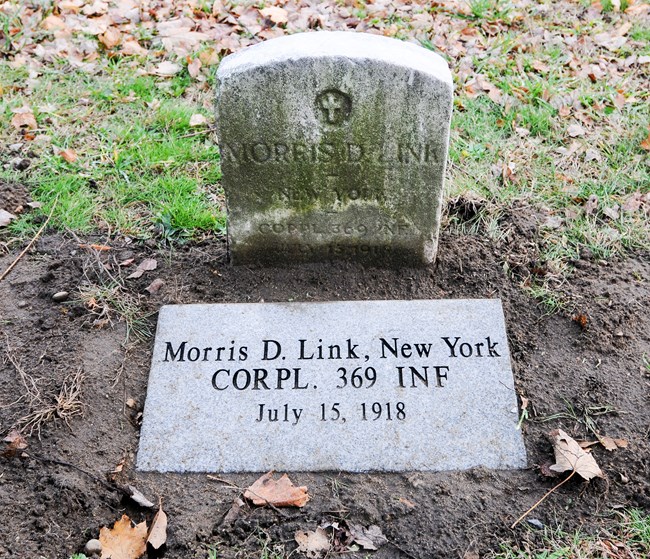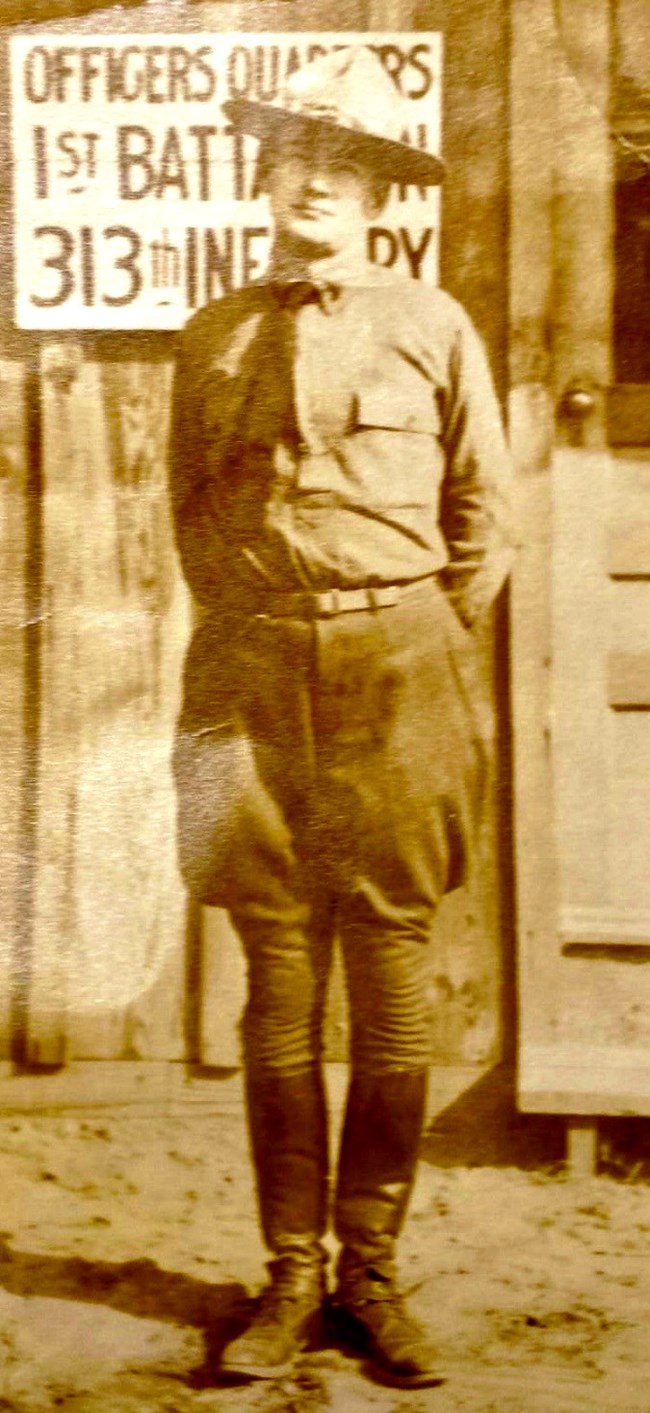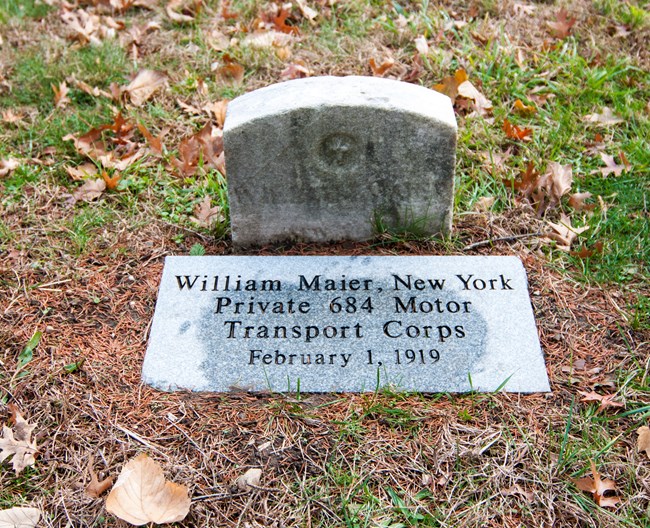Last updated: April 28, 2022
Article
The First World War and St. Paul's Church
In the final year of commemorating the centennial of the First World War, a series of observations emerge through an exploration of the history of St. Paul’s Church National Historic Site.
The most immediate confirms the general military history of St. Paul’s Church. Soldiers of the Great War buried here -- whether they died in service or lived through the conflict -- were residents of this community, and are interred on the grounds, usually with their families, because this was home. Burial markers memorializing their final ten resting places are scattered over the five acre cemetery that displays a variety of carving styles and iconographic symbols on gravestones of approximately 8,000 people who lived in this corner of America since the early 1700s. .
The ten soldiers buried here were incorporated into the immense enterprise of mobilization, service and sacrifice characterizing the First World War. These young men – volunteers or draftees -- served honorably, fulfilled their obligations of citizenship and helped to achieve victory, consummated with the German surrender on November 11, 1918. Among the active soldiers of the World War who lie in the churchyard, there is one medal winner (awarded by a foreign government), no iconic heroes, and only one officer. They are the common servicemen, from the ranks, citizen soldiers. These descriptions and profiles also apply when discussing the St. Paul’s cemetery and the soldiers and seamen of the Civil War or the Spanish-American War.
The most immediate confirms the general military history of St. Paul’s Church. Soldiers of the Great War buried here -- whether they died in service or lived through the conflict -- were residents of this community, and are interred on the grounds, usually with their families, because this was home. Burial markers memorializing their final ten resting places are scattered over the five acre cemetery that displays a variety of carving styles and iconographic symbols on gravestones of approximately 8,000 people who lived in this corner of America since the early 1700s. .
The ten soldiers buried here were incorporated into the immense enterprise of mobilization, service and sacrifice characterizing the First World War. These young men – volunteers or draftees -- served honorably, fulfilled their obligations of citizenship and helped to achieve victory, consummated with the German surrender on November 11, 1918. Among the active soldiers of the World War who lie in the churchyard, there is one medal winner (awarded by a foreign government), no iconic heroes, and only one officer. They are the common servicemen, from the ranks, citizen soldiers. These descriptions and profiles also apply when discussing the St. Paul’s cemetery and the soldiers and seamen of the Civil War or the Spanish-American War.

NPS Photo

NPS Photo
In terms of unit classification of the Doughboys (a common nickname for American soldiers) buried at St. Paul‘s, one troop in particular stands out. It is the 2nd Antiaircraft Machine Gun Battalion, whose ranks included three soldiers buried at this cemetery. Organized at Camp Wadsworth, South Carolina, in January 1918, the battalion deployed overseas in June, and returned in February 1919, demobilizing at Camp Dix, New Jersey. Men in these commands were often posted behind the combat lines, and assigned the broad goal of destroying enemy observation aircraft to impair reconnaissance abilities. Relieved of the deadly obligation of trench warfare and frontal assaults, antiaircraft machine gun units suffered relatively low casualty rates. Unit histories also record that the 2nd battalion was engaged at the Meuse Argonne offensive -- the largest land battle every fought by the American Army -- in support of infantry crossings of the Meuse River.
Enrollment of three men in a battalion from one small American municipality would indicate a locality-based pattern of assigning soldiers to units. Mt. Vernon at the time was a growing but still relatively small city of about 35,000 people, with one high school. It is likely that these soldiers were acquainted prior to entering the army. Among them, James Virus was an usher at a local theater when he was drafted. John Flynn, the brother of Ramsey, was employed at an insurance company in lower Manhattan -- a daily commuter on the railroad -- when he joined the battalion in 1918. Both men had been born in Mt. Vernon.
The third member of the unit buried at St. Paul’s was Stuart Robinson, a Mt. Vernon plumber at the time of his induction. His experiences reflect the dominant, tragic impression revealed through a review of the Great War soldiers. Private Robinson died in France on February 14, 1919 of pneumonia caused by influenza, one of five soldiers buried at St. Paul’s who succumbed to the contagion which swept through the lines in late 1918 and early 1919 -- the final stages of combat and the immediate aftermath period of de-mobilization.
A worldwide pandemic, influenza spread rapidly through the crowded conditions of military camps on the eastern seaboard of the United States and the trenches of the Western Front in Europe. The virus traveled from camp to camp and aboard the ships transporting thousands of Doughboys to Europe in 1918, and struck as much as one third of the American forces mobilized for the war. An estimated 30,000 died before even reaching France. More than half of the 116,000 American military fatalities of the war were caused by disease. The numbers of civilian deaths were also appallingly high. Conservative estimates calculate that 675,000 American died and at least 20 million people perished around the world.
These numbers are staggering, and the literature on the pandemic is considerable, but here at this site, the sobering human dimension of the tragedy cutting down young soldiers comes into focus. John Richard Griffith, a popular Mt. Vernon boy and recent high school graduate who excelled at mechanical work, was assigned to Company 555 of the Motor Transport Service when he died on Governor’s Island in New York harbor on January 16, 1919. John Walter Hodge was a landsman, the preliminary rank for new recruits in the Navy, and died as a result of influenza on September 21, 1918, at a station in Newport, Rhode Island, less than two months after enlisting. An accountant at a New Jersey firm, Hodge lived with his family on South 1st Avenue in Mt Vernon. He was 21.

NPS Photo
After the First World War, Mt. Vernon planted trees in honor of each of the city’s fallen soldiers.
